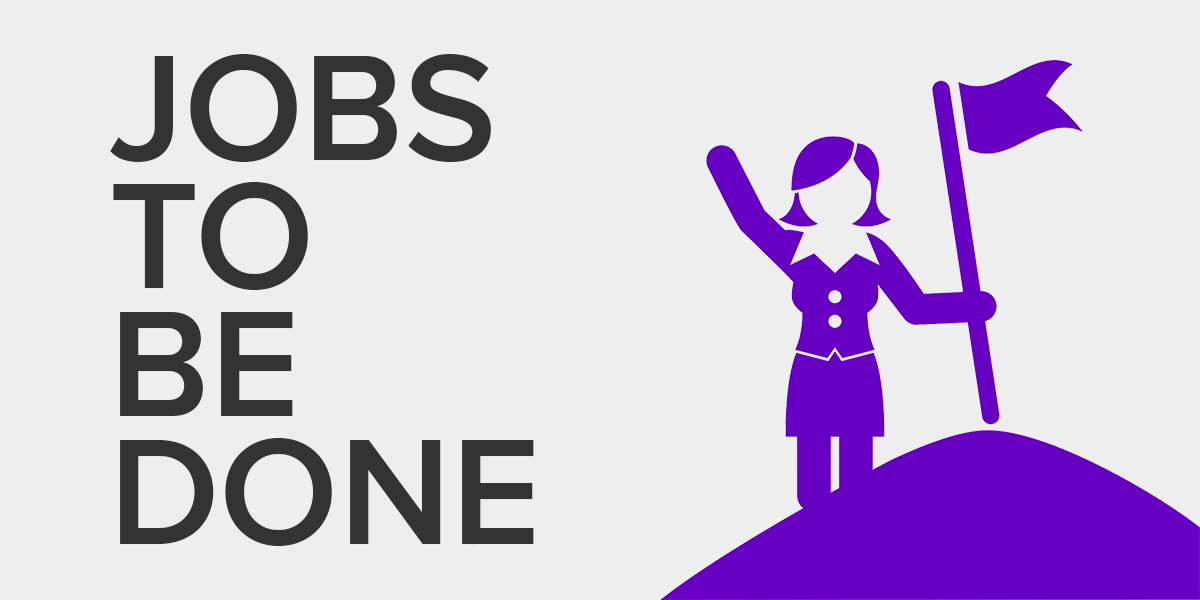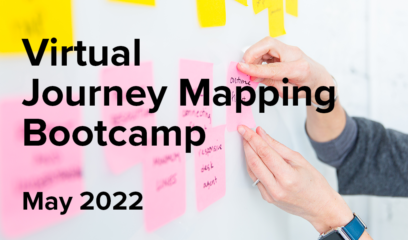We’re often asked how the framework of customer jobs-to-be-done fits with the methodology of customer journey mapping. Here’s my perspective on how jobs theory can complement your mapping efforts.
The term “jobs-to-be-done” first surfaced in 2003, coined by Clayton Christensen in The Innovator’s Solution, but its philosophy shares underpinnings with older models like goal-directed and activity-centered design. In a 2016 issue of the Harvard Business Review, Christensen and his co-contributors summed up the concept as the “need to home in on the progress that the customer is trying to make in a given circumstance—what the customer hopes to accomplish.”
In other words: Ask not what your customers are doing with you. Instead, ask what your customers are trying to do, period.
Your organization is the means by which your customers are achieving an end. The jobs-to-be-done framework shifts the focus to that end-state. You’ve probably seen motivational posters that extol the value of the journey over the destination. But for your customers, a scenic journey that doesn’t achieve their actual goal is a deal-breaker. The destination is mission critical.
For example, a small business owner who uses a shipping company to distribute her wares might need to drop off a package. But the quickest, most seamless package drop-off experience in the world could still leave this customer dissatisfied because that’s just her current task, not her ultimate goal. She is using the shipping company as a means to her end: Give my customers confidence that what they’ve ordered will arrive on time and unharmed. Only by understanding the “why” behind her task can the shipping company determine what she needs along the way. Does she need help packing fragile items? Would she be willing to pay extra for pickup service? What kind of tracking info is needed, and to whom should it be available? The “why” helps point the way.
Keeping the job top of mind also helps spot potential disruptors and opportunities for innovation. For instance, I’m a frequent shopper at several local groceries, but my goal is never “walk to the Whole Foods on Beacon Street.” Instead, I’m throwing a dinner party for six friends—and as a city-dwelling Millennial, I’m doing it without the use of a car or much patience for errands. By understanding this, Whole Foods realizes that my business isn’t at risk from the new Wegman’s a couple miles away. Instead, they must compete against other ways I might get the job done, like foregoing the trip in favor of a grocery delivery service or skipping the cooking altogether by ordering takeout on GrubHub.
Here’s the good news: You don’t need a separate tool to track your customers’ jobs-to-be-done. You just need to use the framework as a lens on your journey maps to maximize their effectiveness. Any time you’re drafting or revising a map, ask yourself these questions:
Who’s going through this journey and why?
Every journey needs an accompanying persona. Different customers have different needs and expectations—they are trying to accomplish different jobs. Determine the destination your persona is working toward and what constraints he’s working under to get there. Strip out demographics that don’t help you empathize with his goal. Instead, consider how his attitudes and behaviors impact what he’s trying to do. Would he rather spend more time or more money? What are the things he’s most motivated and/or frustrated by? What does success look like for him personally or professionally? Prioritize info that will empower map readers to understand the “why” behind your persona’s journey.
What else is the persona doing in pursuit of their goal?
Even when crafted in customer-friendly language, journey maps too often take a myopic view of the story. Maps that only show where the customer is interacting with your own touchpoints miss critical opportunities to generate empathy and provoke innovative solutions. Challenge your team to explore the white space between steps in the journey (and then to validate your hypotheses with customers). Is the persona checking his bank statement to make sure the monthly budget will stretch? Doing research on your competitors? Picking up his kids from soccer practice? The context that frames your customers’ jobs-to-be-done will help you speed them toward their destination.
The jobs-to-be-done lens isn’t an “all’s well that ends well” free pass to ignore the journey along the way. But you have to understand your customers’ ends in order to provide the right means. Figure out what they’re trying to do—not just with your company, and not just right this second. Once you understand the job they are completing, you can design and deliver the right journey to get them there.




